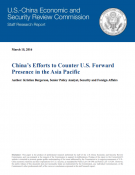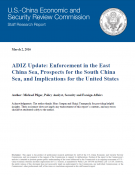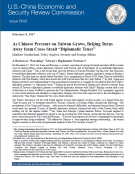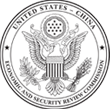×
Filter Results
Filter Results


Staff Paper
While the People’s liberation Army continues to build anti-access/area denial capabilities to deter or delay a U.S. military response to a potential conflict with China, Beijing also appears to be pursuing other options—including nonmilitary options prior to a conflict—likely intended to erode the United States’ strategic position, freedom of action, and operational space in the Asia Pacific. The nonmilitary options being pursued include engagement, coercion, and alliance splitting focused on U.S. allies and partners in the Asia Pacific region. Although Beijing’s attempts to limit U.S. force projection capabilities in Asia through these efforts have produced mixed results, there is little indication Beijing will abandon its efforts to mitigate the U.S. military presence in the region.


Staff Paper
This report assesses the extent to which China has enforced its air defense identification zone (ADIZ) in the East China Sea, and considers the potential conditions and implications of a Chinese ADIZ in the South China Sea.


Contracted Research
The report examines the Chinese government’s actions to promote the use of its currency, the renminbi (RMB), in the global monetary system as a payment currency for cross-border trade and financial transactions, a vehicle currency for foreign trade and international capital transactions, and a reserve currency. The report analyzes the potential effects of the rising prominence of the RMB on the financial clout of the United States and the U.S. dollar’s role in denominating international trade transactions and settling cross-border financial transactions.

Issue Brief
On January 16, 2016, Taiwan held its presidential and parliamentary elections. Focusing on economic and local issues in the campaign, the Democratic Progressive Party (DPP) presidential candidate Tsai Ing-wen and her running mate Chen Chien-jen won the election with over 56 percent of the vote, while the traditionally pro-independence DPP captured an outright majority in the Legislative Yuan (LY) for the first time in Taiwan’s history, winning 68 of 113 seats. With the DPP’s victories in the presidential and LY elections, the party can pursue its economic and cross-Strait goals. This issue brief analyzes the results of Taiwan’s elections and discusses the implications of the elections for cross-Strait relations and the United States.

Issue Brief
After the stock market turmoil last August, Chinese regulators were hoping for a peaceful start to the year, preparing to wind down the ban on sales for big shareholders and launching a new mechanism (a circuit breaker) designed to prevent dramatic falls on par with those seen last year. The plan backfired. China’s Shanghai and Shenzhen stock markets crashed on January 4, the first day of trading, followed by another crash on January 7; in both cases, the circuit breaker halted trading. The combined rout erased more than $1 trillion of value. The government’s attempts to stem the meltdown only worsened the situation, confusing investors and raising fresh doubts over the ability of the Chinese government to manage a slowdown in the economy. They also exposed the contradiction inherent in the Chinese Communist Party (CCP) leadership trying to introduce market-oriented policies for the broader economy while maintaining control over the composition and behavior of the Chinese stock markets—an approach that leads to greater volatility and moral hazard.

Research
The U.S.-China Economic and Security Review Commission invites submission of proposals to provide a one-time unclassified report on China’s industrial and military robotics development. Electronic or hard-copy proposals must be submitted by 5:30PM (EST) on February 02, 2016.
